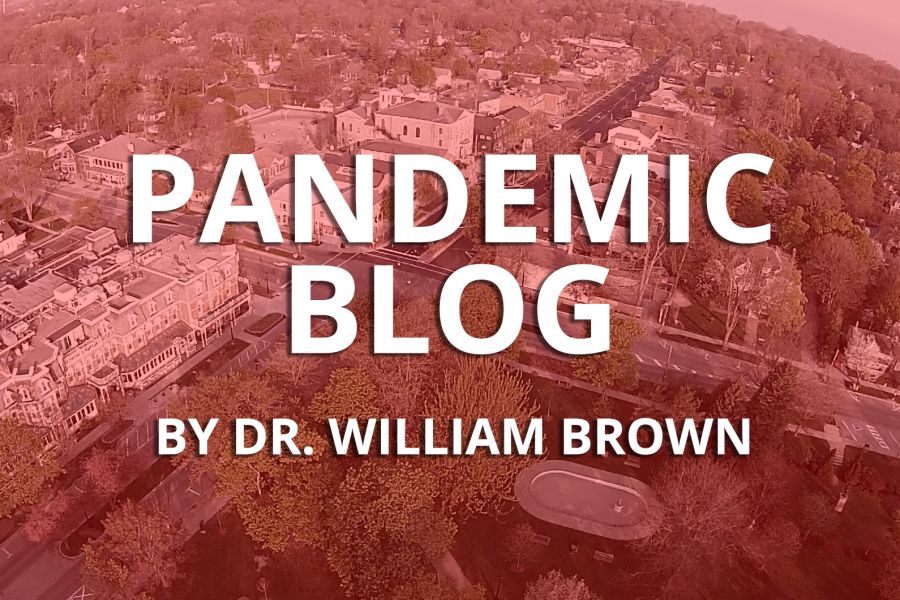Dr. William Brown
Special to The Lake Report
Some liken the current pandemic and financial crises to Black Swan events – rare as the chance of spotting black swans (they exist is Australia, it turns out) – which catch everyone by surprise, have horrific consequences and following which, experts claim they saw it coming.
The two are linked – the pandemic threatens millions, kills many thousands and has shut down economies worldwide.
This pandemic blindsided most governments but was no surprise to those familiar with previous viral epidemics. In the past 20 years there was SARS-1 in 2003, MERS in 2012, the Zika virus in 2014 and the latest Ebola outbreak in West Africa in 2013-2016.
All were lethal – Ebola was the worst, killing half those infected. In the 20th century, there were a series of viral epidemics, the worst of which was the Spanish flu in 1918-1920, which killed 50 million or more – as many as were killed in the FIrst World War.
COVID-19, was found first in bats in China in 2017 and considered a potential threat to humans the same year – a full two years before the first acknowledged outbreak in humans in late 2019 in Huanan city, the site of the infamous “wet market,” in Wuhan province.
China officially notified the World Health Organization and U.S. Centres for Disease Control on Dec. 31, 2019, but it was a month later, on Jan. 30 before the WHO declared COVID-19 a “public health emergenc” – a very long delay, given the rapid spread of the disease within those first few critical weeks.
COVID-19 belongs to the corona family of viruses and is most closely related genomically to the SARS-1 virus. It came as no surprise, therefore, to learn that COVID-19 caused Severe Acute Respiratory Syndrome (SARS) in some patients akin to that observed with SARS-1 and MERS 9. However, the molecular targets and therefore symptoms and sometimes organ failures associated with COVID-19 are broader, including the heart, kidneys, bowel and other organs.
What initially surprised many was the rapidity of the spread, and potential – fully realized in some countries – for swamping health care systems, such as China’s in the early days of the pandemic, much of Western Europe, especially Italy, Spain and the U.K., and more recently New York City.
With such an explosive spread came shortages of key items such as quality face masks, gowns and ventilators. Critically important to success or failure has been the extent to which health care systems were able to pivot to face the onslaught of COVID-19 cases. Unfortunately, the same has not been true for long-term care facilities, where containing the spread of the disease was much harder and fatality rates in older residents and patients sometimes reached 30 to 50 per cent.
But even if this pandemic and the accompanying economic chaos following the earliest discovery of this particular coronavirus in 2017, there was no way of knowing this virus would prove so socially and economically disruptive or cause so many deaths, all within two to three months, with no clear end in sight as I write.
Once COVID-19 reached humans in Wuhan province in late 2019 it was clear sailing – the virus was highly infectious and a killer for many. The reasons are the same as those which will favour future pandemics caused by other opportunistic viruses – there are lots of human hosts, almost 8 billion now, there will be little if any natural immunity, and humans travel worldwide, mixing with others along the way, at our destinations and homes when we return.
That’s the perfect storm – opportunity, poor defence and a host (us) that spreads the virus freely and quickly.
From a molecular perspective, coronaviruses, like many RNA viruses, are simple creatures – they possess a small single strand of RNA wrapped in a glycoprotein shell and are incapable of making it on their own without the help of living cells to make copies of themselves.
Yet they can do precisely that in any species immunologically naïve enough for the virus to gain a foothold. And, like any other RNA virus, they have another trick – RNA is inherently unstable and easily mutates. That gives the virus a leg up because over the course of trillions and trillions of copy cycles, sooner or later mutants will emerge, capable of overcoming whatever defences we have acquired to earlier versions.
It’s one version of what’s been called “Evolution on the FastTrack” and no friend of humans in this case.
PS: Recent evidence suggests that the need for ventilators may not be so pressing, given the option of using CPAP (Continuous Positive Airway Pressure) devices similar to those used for treating sleep apnea, as a far less invasive, less damaging to the lungs, option for some patients.
Dr. William Brown is a professor of neurology at McMaster University and co-founder of the Infohealth series held on the second Wednesday of each month at the Niagara-on-the-Lake Public Library.










